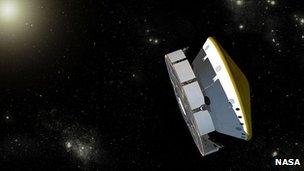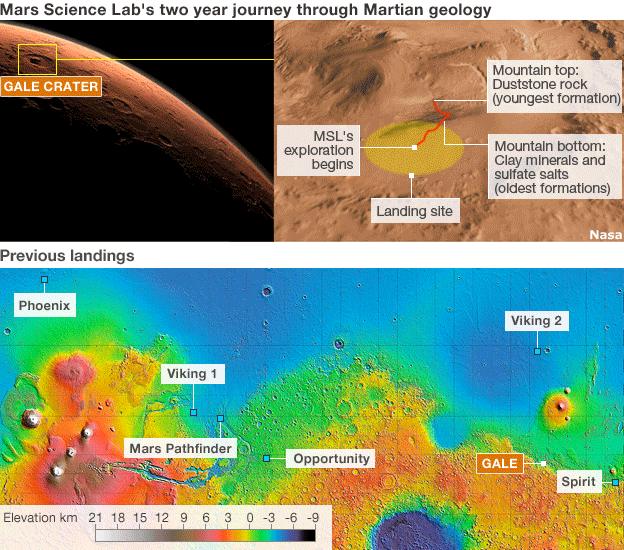Nasa Mars rover mission lines up on target
- Published
Nasa's Mars Science Laboratory (MSL), currently en route to the Red Planet, has had its course corrected to put it on target for an August landing.
The 900kg rover is flying through space at 4.5km/s following its launch on an Atlas rocket from Florida in November.
Wednesday's manoeuvre ensures MSL is properly lined up on Mars, leaving the Atlas, which is following behind, to miss the planet.
The roving lab is aiming to land inside a 150km-wide bowl called Gale Crater.
It will use its sophisticated instruments to assess whether the location has ever had the conditions capable of supporting life.
The course correction involved firing the eight thrusters on MSL's cruise stage in a planned sequence that lasted almost three hours.
The cruise stage is the support vehicle that is carrying the rover to the Red Planet. The laboratory itself is tucked away inside a protective cone-shaped capsule.
All of this equipment will have to be jettisoned for MSL to make its landing, expected to take place on the morning of 6 August (GMT).
The thruster firings initiated what is expected to be the biggest change in course for the probe during its nine-month, 570-million-km-long journey to the Red Planet.
Further manoeuvres, however, will still be needed to precisely point MSL at its destination, with a last correction being made perhaps just before the mission's entry into the Martian atmosphere.
Changing course like this mid-way through a cruise is standard practice.
Planetary protection protocols drawn up by scientists demand that space missions limit the amount of earthly contamination they take to other worlds, and while MSL was prepared to exacting standards of cleanliness the same could not be said of its Atlas launcher.

The rover is tucked inside a protective shell attached to the cruise stage
Wednesday's manoeuvre guarantees the upper portion of this vehicle, which has been trailing behind the rover after giving it a final push, cannot now impact Mars.
MSL, also known as Curiosity, is the biggest, most capable spacecraft ever sent to touch the surface of another planet.
Getting down on to planet will not be easy; most efforts have failed. But the Americans have a good recent record and they believe a new rocket-powered descent system will be able to place the rover in one of the most exciting locations on the planet.
Curiosity will investigate a central mountain in Gale Crater that is some 5km high.
It will climb the mountain, and, as it does so, study rocks that were laid down billions of years ago in the presence of water.

Jonathan.Amos-INTERNET@bbc.co.uk and follow me on Twitter, external
- Published26 November 2011
- Published24 November 2011
- Published14 October 2011